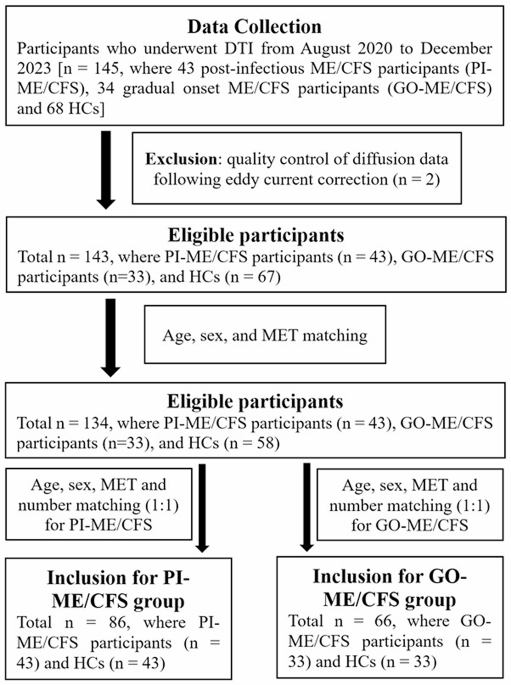John Mac
Senior Member (Voting Rights)
Abstract
While post-infectious (PI-ME/CFS) and gradual onset (GO-ME/CFS) myalgic encephalomyelitis/chronic fatigue syndrome (ME/CFS) manifest similar symptoms, it has long been suspected that different disease processes underlie them.However, the lack of biological evidence has left this question unanswered.
In this study, how white matter microstructural changes in PI-ME/CFS and GO-ME/CFS patients were investigated.
PI-ME/CFS and GO-ME/CFS patients were recruited based on consensus diagnoses made by two experienced clinicians and compared their diffusion MRI features with those of rigorously matched healthy controls (HCs) with sedentary lifestyles.
PI-ME/CFS participants showed significantly higher axial diffusivity (AD) in several association and projection fibres compared to HCs.
Higher AD in PI-ME/CFS was significantly related to worse physical health.
In contrast, GO-ME/CFS participants exhibited significantly decreased AD in the corpus callosum.
Lower AD in GO-ME/CFS was significantly associated with worse mental health in commissural and projection fibres.
No significant group differences were found for fractional anisotropy, mean diffusivity, or radial diffusivity.
Distinct patterns of AD alterations in PI-ME/CFS and GO-ME/CFS provide neurophysiological evidence of different disease processes and highlight the heterogeneities of ME/CFS.

Distinct white matter alteration patterns in post-infectious and gradual onset chronic fatigue syndrome revealed by diffusion MRI - Scientific Reports
While post-infectious (PI-ME/CFS) and gradual onset (GO-ME/CFS) myalgic encephalomyelitis/chronic fatigue syndrome (ME/CFS) manifest similar symptoms, it has long been suspected that different disease processes underlie them. However, the lack of biological evidence has left this question...
